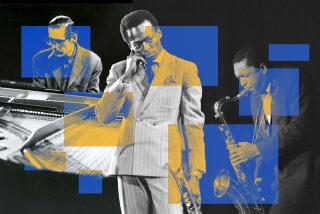Review: A fascinating education in âThe Jazz Standardsâ
The Jazz Standards
A Guide to the Repertoire
Ted Gioia
Oxford University Press: 528 pp., $39.95
I like jazz but I donât know much about it. Or perhaps I should say that I know what I like. Duke Ellington, Bessie Smith and Benny Goodman, yes, but my appreciation really kicks in with the beboppers, Monk and Bird and Dizzy, and their spiritual brethren (or descendants): Miles Davis and John Coltrane. Throw in a little Billie Holiday, some Dave Brubeck and Stan Getz, and there you have it: my autodidactâs pantheon.
And yet, as Ted Gioia points out in his monumental âThe Jazz Standards: A Guide to the Repertoire,â this is true in many ways for everyone. âMy own education in this music was happenstance and hard earned,â the jazz historian and pianist acknowledges in a revealing introduction. â⌠Aspiring musicians today can hardly imagine how opaque the art form was just a few decades ago â no school I attended had a jazz program or even offered a single course on jazz.â
âThe Jazz Standardsâ is an attempt to offer a kind of one-stop shop overview of the genre, looking not so much at the musicians as at the songs. An alphabetical survey of 252 classic pieces, it is to some extent an extrapolation of âThe Real Bookâ â âthe underground collection of jazz lead sheets that began circulating in the 1970sâ that itself grew out of a series of âfake books,â bootleg compilations used by jazz players to work their way through the entire tradition. This history is fascinating, a reminder that jazz is at heart a vernacular medium in which the most essential skill for a musician may be the ability to think on his or her feet.
âI recall the lament of a friend,â Gioia writes, âwho was enlisted to back up a poll-winning horn player at a jazz festival â only to discover that he wouldnât be told what songs would be played until the musicians were already on stage in front of 6,000 people. Such instances are not unusual in the jazz world, a quirk of a subculture that prizes both spontaneity and macho bravado. Another buddy, a quite talented pianist, encountered an even more uncooperative bandleader â a famous saxophonist who wouldnât identify the names of the songs even after the musicians were on the bandstand. The leader would simply play a short introduction on the tenor, then stamp off the beat with his foot ⌠and my friend was expected to figure out the song and key from those meager clues.â
What makes âThe Jazz Standardsâ so engaging is just this sort of anecdotal texture, Gioiaâs ability to write as an inhabitant of both the tradition and the songs. He takes us through music thatâs well known (âBeale Street Blues,â âMy Funny Valentine,â âMood Indigo,â âEmbraceable Youâ) and not so well known (âNardis,â âBillieâs Bounce,â âEast of the Sun (and West of the Moon)â), but either way, his connection is a starting point.
âWhen I was a very young child,â he recalls, discussing the song âIâll Remember April,â âI saw the Abbott and Costello movie âRide âEm Cowboyâ on several occasions on television, but I have no recollection of âIâll Remember April,â which was introduced in this unlikely film by Dick Foran. But a decade later, I encountered âIâll Remember Aprilâ again â this time in a version by pianist Erroll Garner from his landmark album âConcert by the Sea.ââ From there, he riffs briefly about Garner (âI am convinced that a young musician could build a killing style using his tricks and techniques as a foundationâ) before highlighting a dozen or so covers by artists including Getz, Keith Jarrett and Frank Sinatra, who recorded it in 1961.
Here we see Gioiaâs method in microcosm: to move from the general to the specific, and in so doing, to trace the saga of the song. This is especially interesting when thereâs real history to uncover; his entry on âSt. James Infirmaryâ goes back to 16th century England, making clear âthe oft-forgotten folkloric roots of jazz,â while his explication of âShine,â first recorded by Louis Armstrong in 1931, reveals an unexpected link to gender reversal: the song had been popularized 20 years earlier by a female performer, Aida Overton Walker, who went onstage dressed as a man.
To call âThe Jazz Standardsâ a work of history, however, is to miss at least half the point; it is also a work of criticism, and Gioia is not afraid to offer pointed commentary. He opens his discussion of âMack the Knifeâ by declaring, âI often cringe when I hear this song,â and he dismisses âTea for Twoâ as âmonotonous and akin to a second-rate nursery song.â But hereâs where Gioiaâs critical acumen asserts itself, as he moves beyond his own response to conjecture about the popularity of the song.
âI suspect that the ease with which the song is adapted to ulterior purposes is what keeps it in the jazz repertoire,â he writes in reference to a pair of 1937 recordings, one âan uncharacteristically graceful and subdued performanceâ by Fats Waller, the other Django Reinhardtâs âimpressive reworking of the songâs underlying harmonies.â Then, he fantasizes about an imaginary meeting between Thelonious Monk and the classical pianist Vladimir Horowitz, who recorded the song three months apart in 1963.
Monk and Horowitz, Gioia tells us, were at the same studio on the day the latter cut his ânever released version,â and he ends his account by admitting that he enjoys âspeculating on what might have happened if Monk had joined Horowitz in a duet to show him how it should be played.â That line gets very close to the heart of things, with the improvisational master schooling the formally trained musician, teaching him to find the spirit, if not necessarily the letter, of the song.
In a sense, of course, this is what Gioia is also doing with âThe Jazz Standards.â What is the book, after all, if not an extended improvisation, beginning with its framing of the repertoire? Such a repertoire is fluid, and if in recent years it has undergone a âprocess of codification,â his approach canât help but be subjective, defined by his experience and sensibility. To read âThe Jazz Standards,â then, is not unlike listening to Gioia play his way through this music, sharing not just what he likes (and dislikes) but also what he knows.
More to Read
The biggest entertainment stories
Get our big stories about Hollywood, film, television, music, arts, culture and more right in your inbox as soon as they publish.
You may occasionally receive promotional content from the Los Angeles Times.











